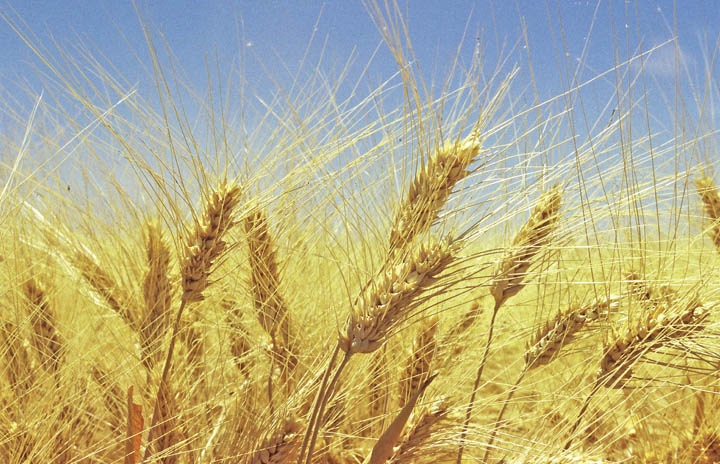September 17, 2012

Stripe rust resistant wheat varieties can disappear faster than a cowboy’s paycheck on a Friday night in Clovis, N.M.
It’s a never-ending disappearing act that’s setting up California’s wheat industry for a “perfect storm,” in the 2012-2013 winter wheat production season, according to Steve Wright, University of California Cooperative Extension farm advisor for Tulare County.
Grain prices are expected to be strong for the California wheat crop that will be seeded this fall, Wright told growers and others at the Alfalfa and Forage field day at the UC Kearney Research and Extension Center, Parlier, Calif.
Prices “close to that of some permanent crops” will no doubt result in a sharp increase in planted acres this fall from the 2011-2012 800,000 acres of all wheats in the state.
Wright is hearing of prices of $300 per ton for 2013 wheat. At that price, 2.75 tons per acre of grain is a breakeven point. However, yields of 4 tons of irrigated wheat are not uncommon. Although rare, 5-ton yields are possible, Wright says.
These prices are a result of concerns over the world wheat supply. Traders are expecting Russia to implement some kind of export curb by the end of the calendar year, despite promises by the Russian government not to do so. Other major exporters also entered the picture. Ukraine's government and the country's grain traders made an informal agreement to limit grain exports. Flooding in Argentina is causing damage in the country's No. 1 wheat growing state of Buenos Aires. Drought conditions are cutting production and export expectations for Western Australia. Traders are expecting many buyers to depend on North American wheat supplies late in the marketing year.
That sounds well and good for California wheat growers, except that the three leading wheat varieties planted in California in 2012 (Joaquin, PR 1404 and Red Wing) are susceptible to stripe rust. Joaquin is the most susceptible of the bunch and it was the most widely planted variety in the state last season. It once was classified as very tolerant. PR 1404 is moderately resistant, and Redwing, which was resistant, is now moderately susceptible.
Redwing “might have one more year,” says Wright.
Previously popular varieties like Summit and Blanca Grande were once highly resistant and now are highly susceptible. Yecora Rojo fended off rust for 25 years. Summit was resistant for only three seasons.
Wright mentioned Joaquin Oro as the newest stripe rust resistant variety, but “I am not sure how much seed will be available” this fall to plant.
There are 137 identified wheat stripe rust races in the U.S. with 17 new ones identified each year.
Rapid rust spread
“This makes it difficult for breeders to keep up in releasing stripe rust resistant varieties,” Wright said.
Stripe rust spores are wind-borne and can travel hundreds of miles on the currents. The fungus grows only on living host plants and survives between seasons on volunteer wheat, barley plants, and some wild grasses. Rust spores are spread by wind to initiate infections. Disease development is most rapid at temperatures of 50-60 F (10-16 C) with intermittent rain and dew, although the disease can continue to develop at higher temperatures and drier conditions; secondary cycles occur at seven to 10-day intervals. Wright says new stripe rust spores develop in the Sacramento Valley and are flown into the Central Valley on the wind.
Stripe rust was first identified in California in 1993-1994.
Growers would be wise to plant resistant varieties, but they may not be available and growers have no alternative but to plant susceptible varieties and hope stripe rust does not make an appearance as it did in 2003 when yields losses were as high as 75 percent from stripe rust.
The disease developed early that year and was more severe than normal throughout much of the U.S. A combination of very mild winter temperatures (particularly December through January) and early sowing resulted in very early infections, about six weeks earlier than normal for California’s Central Valley. Cool conditions persisted much longer in the spring than usual, and stripe rust reached very high levels throughout the Central Valley.
Wheat is susceptible from as early as January and as late as April, says Wright.
If a grower is cursed with a susceptible variety and stripe rust blows in, Wright recommends 10 percent hot spots on leaves to trigger a fungicide application.
There are five registered fungicides in California that will control stripe rust: Stratego, Tilt, Quadris, Quilt and Headline.
These varieties are classified as “highly susceptible”: Yecora Rojo, Dirkwin, Joaquin, Mika Bonus, Brooks, Anza and Blanca Grande.
“Susceptible” are WB-Paloma, Pacheco and Summit.
“Moderately Susceptible” are Red Wing, Kronos, Duraking, Clear White and WB-Cristallo.
“Moderately resistant” are PR 1404, Trical 118, Westmore, Ultra, Camelot, Crown, Platinum, Topper, Blanca, Fuerte, Volante, Trical 105 and Desert King.
“Resistant” are Cal Rojo, Blanca Grande 515, Summit 515, Fortissimo, Lariat, Lassik, Patwin, Blanca Royale and WB-Rockland.
About the Author(s)
You May Also Like






